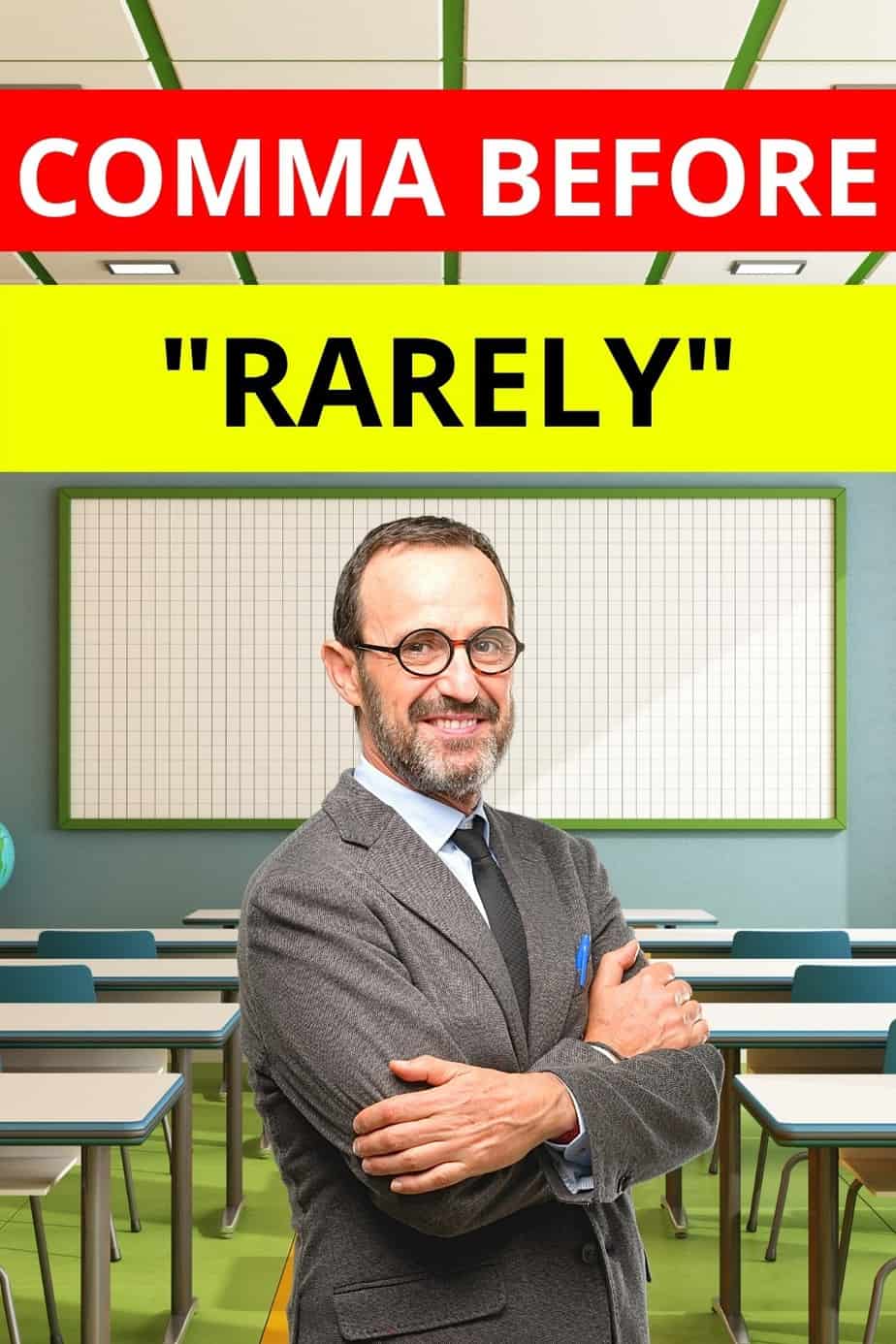Deciding on whether to place commas in sentences can be a thorny and gruesome path to take.
And, it is safe to assume that everyone has come to this conflicting point at least once in their lifetime, natives and non-natives alike.
So why don’t we try to disentangle the web of guiding principles on comma usage, particularly before the word “rarely.”
[toc]
When do we need a comma before “rarely”?
In a nutshell, rarely does a comma appear before “rarely,” and indefinite adverb of frequency. However, we may need a comma to pre-signal parentheses, those that are interesting yet grammatically-irrelevant ideas within a sentence. With this, a pre-comma also needs to be used when “rarely” comes after a parenthetical insertion. Also, a comma should precede it in a serial list, which is quite self-explanatory. But, note that a comma is not needed when it is non-parenthetically used to modify verbs, adjectives, or adverbs, which is almost always the case.
Rarely: Meaning, Function, and Usage
The word “rarely” is an adverb that expresses how often something happens.
Quite a vague explanation, yes? Don’t worry because that’s actually the point.
“Rarely,” an indefinite adverb of frequency, expresses a relatively vague meaning, as opposed to definite adverbs like weekly, monthly, or yearly.
Definite frequency adverbs help us accurately quantify rates of occurrences, whereas indefinite adverbs help in expressing these ideas more easily.
Definite adverbs are more useful in conversations or texts requiring a more straightforward expression, such as in describing research results.
However, describing events in daily conversations need not be exhaustively nor meticulously measured at all times.
This is when our indefinite adverbs come in, such as the word “rarely” which roughly means “hardly ever” or “seldom.”
Thus, it means that it may be identified somewhere between “never” and “sometimes,” depending on the language user’s reference point.
A planetary collision, at least in our solar system, has never happened, while living up to 100 years old these days rarely happens.
Although I might suggest that living up to 100 years is a rare occurrence, this take is just a general idea based on my perspective.
Therefore, indefinite adverbs help in creating an approximate deduction of an event’s occurrence rate rather than an accurate one, which makes communication easier.
Now that we have understood how “rarely” functions and what role it plays in creating sentences, let’s move on to commas.
A break down of the guidelines on the comma before “really”
Before breaking the “rules” down, we must first understand that comma placement is not as essential as death and taxes.
Commas were actually developed before the “rules” came about, which happened mainly for convenience and clarification reasons.
As our Greek and Roman ancestors used to write without spaces and punctuation marks, these devices were invented later on to disambiguate their texts.
Another reason is that several style guides dictate the fields of discipline at present, so there is really no single, definite rule for perfect punctuation.
So, instead of memorizing what people generally perceive as “comma rules”, we had better focus more on understanding how sentences work based on disambiguation and aesthetics reasons.
What I’m trying to say is that most of the forthcoming explanations are based on both syntactic and stylistic principles, scrupulously simplified for easier comprehension.
All you need to remember are the words “parenthesis” and “series,” and then you’re good to go.
When “rarely” introduces a mid-sentence parenthesis
As language intricacy cannot be merely explained using the prescriptive point of view alone, stylistics also plays a significant role in the process.
In stylistics, a parenthesis is used as a rhetorical or persuasive device to accentuate an interruptive thought that makes a sentence more interesting.
Parenthetical expressions are set off with commas to mark their grammatical independence as well as their highlighting effect.
These expressions can be placed anywhere since they do not necessarily follow the grammatical flow dictated by the sentence.
Look at the example to see clearly.
The parenthetical information interrupts the sentence midway to create some emphatic and informational effect as per the writer’s intention.
Hence, the interruptive clause is segregated from the entire sentence with commas due to its grammatical dispensability.
No matter where the parenthesis is inserted within the sentence, commas must always be used as warning signals.
More importantly, not using commas in encapsulating a parenthetical interruption makes the sentence obscure and hard to read.
When “rarely” introduces an end-sentence parenthesis
Since a parenthesis can be placed pretty much everywhere, it follows that a parenthesis attached at the end of a sentence needs a pre-comma too.
What we have to remember in this type of sentence construction is that the initial clause needs to be able to express a complete thought and must not be dependent on the subsequent information.
Study the next example.
The second clause is a fragment whose meaning is highly dependent on the primary clause since it is attached without any connective device.
When a connective device, particularly a subordinate conjunction, is used, a good writer knows that the sentence does not need a comma at all.
However, in the last example, the pre-comma replaces the job of the conjunction instead, making the punctuation mark highly crucial in the construction process.
This goes back to the reason that any parenthetical expression is free from syntactical adherence and that they are added for emphatic reasons only.
Similarly, the removal of the comma makes the sentence rather clunky and confusing to read.
When “rarely” comes after a parenthesis
Now that the parenthetical comma guidelines have been made clear, it should be easy to understand that a comma must always come after a parenthesis.
The same comma automatically serves as the mandatory comma before “rarely” when it still introduces further information.
Here’s an example to illustrate that.
The fragment introduced by “rarely” is not really that necessary to the meaning of the whole sentence.
It was simply added to add some supporting details to the initial clause which is already grammatically complete on its own.
Thus, a pre-comma is needed to mark that the additionality of the fragment rather than as something that is grammatically important.
This also implies that removing the medial parenthesis would still create a sensible sentence.
If you do not want to use a comma to attach the last information, you may use a connective device instead.

When “rarely” is used in a serial list
The last case necessitating a comma placement before “rarely” is when it is part of a serial list of items, which is quite self-explanatory.
Here’s an example to show that.
That’s a lengthy one, isn’t it? Maybe I could show you a shorter one for an easier read.
It is needless to say that a comma must be placed before any serial elements used after the first item and before the conjunction used to attach the last item.
However, the comma before “and,” known as the Oxford comma, in the example is an optional one.
This means that it can be removed for as long as it does not create any confusion in the text.
When does putting a comma before “rarely” become incorrect?
Put simply, placing a comma before “rarely” would be incorrect when it is used in its most basic function as an adverb.
This means that a comma should not be placed when it is used to modify verbs, adjectives, and adverbs in a non-parenthetical manner.
Here are some specific examples to show what I’m trying to point out.
When “rarely” is modifying a verb
“Rarely” can be used to modify a verb in a sentence, which is its most common function among the three.
Again, using “rarely” means we want to imply the meaning of “hardly ever” which is closer to “never.”
We should not put a comma when it functions this way since its role is to alter the meaning of the verb in the sentence, rather than add additional information.
The sentence implies that the subject shows a relatively exceptional trait, at least in the sense that most dogs are expected to make a lot of noise.
Putting a comma before “rarely” in this type of construction certainly promises a red mark from any teacher or grammar-checker tool.
When “rarely” is modifying an adjective
Another part of speech that adverbs can modify are adjectives, and thus, “rarely” also has the ability to do this.
Similarly, a comma should not be placed before “rarely” when it is used to modify adjectives in a non-parenthetical manner.
A comma before “rarely” would also make the sentence wrong, so it should never be placed in similar cases.
When “rarely” is modifying an adverb
The last modifying power of adverbs can be used on their immediate relatives.
Despite being a relatively less common function compared to verbs and adjectives, this is still possible.
Obviously enough, a comma must not be placed before “rarely” in the sentence below.
“Rarely” modifies the spatial adverb “here” whose meaning is deictically dependent on the language user’s reference point.
This means that it is impossible to know where “here” exactly is without any background information or supporting details.
Frequently Asked Questions on Comma Before “Rarely”
Can we start a sentence with “rarely?”
Yes, when we want to create an emphatic effect that makes use of inverted sentence construction. For example, “Rarely does she wear makeup.” Inversion is not recommended for beginner English learners.
What is a synonym for “rarely?”
“Rarely” denotes a similar meaning to “hardly ever” which is just slightly more frequent than “never.” These adverbs are called indefinite adverbs of frequency.
Do you put a comma before “and” in a list?
We can put a comma before “and,” called an Oxford or serial comma, if we want to avoid creating unintentional ambiguity. This comma is optional in short and clearly-categorized lists such as in this sentence: She loves kiwis, strawberries(,) and peaches.
Conclusion
Although commas can be a hard nut to crack, we should bear in mind that they exist for a highly vital purpose: to disambiguate sentences.
Without commas, the written language will just be like a song without a melody or an open sea without a lighthouse.
Or perhaps, even much more like Bogota, the most traffic-congested city in the world.

Hey fellow Linguaholics! It’s me, Marcel. I am the proud owner of linguaholic.com. Languages have always been my passion and I have studied Linguistics, Computational Linguistics and Sinology at the University of Zurich. It is my utmost pleasure to share with all of you guys what I know about languages and linguistics in general.

